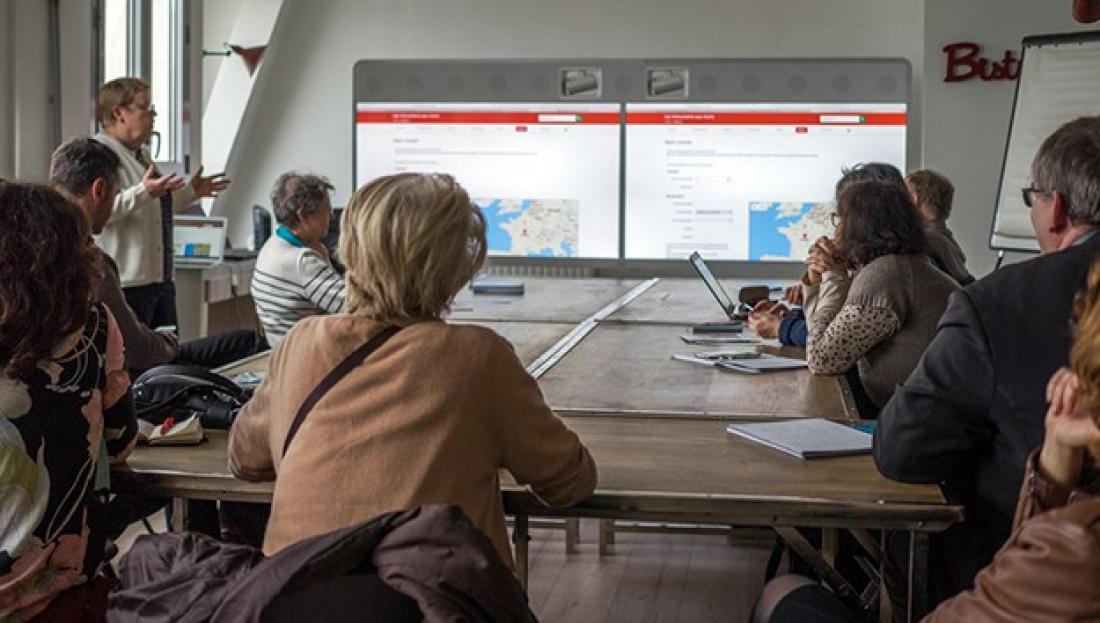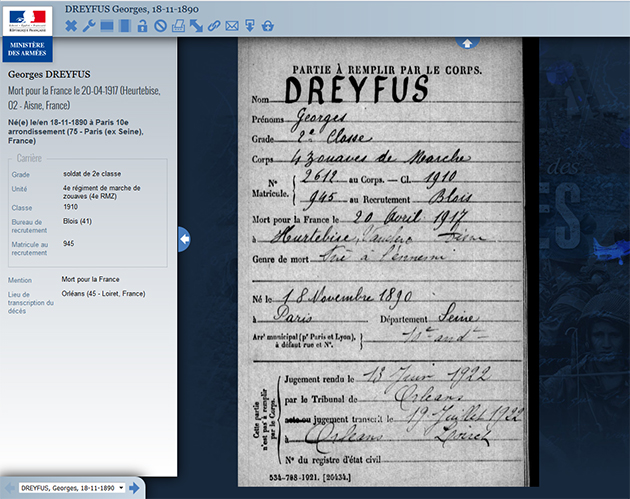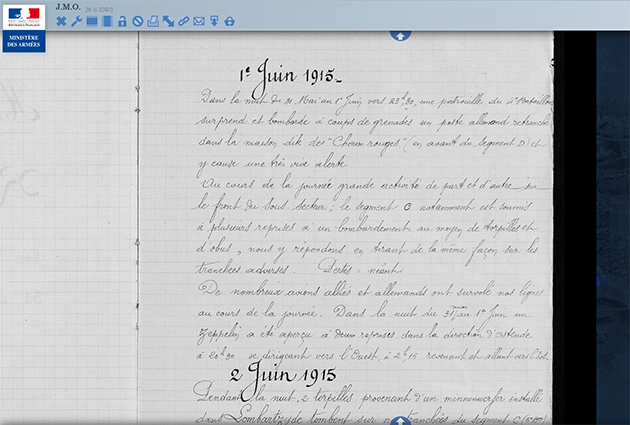Online remembrance practices

For the First World War centenary, the internet came into its own as a tool for disseminating the memory of the 1914-18 conflict. It also became a means by which the State and history enthusiasts could play a part in the commemorations. Already possessing a cultural, educational and scientific identity, the centenary soon gained its own digital identity.
The First World War centenary’s popularity with French society did not diminish throughout the commemorative period (2013 to 2019). Besides the large number of initiatives put in place by the State, departments and communes, the education and voluntary sectors and the academic sphere, which have been surveyed by the Mission du Centenaire, it is worth highlighting the major role played by citizens themselves.
The birth of “web remembrance”
The internet has become brand-new territory for reconstructing collective memory – an indirect memory, disconnected from lived experience, since no surviving witnesses remain, but put together from both private (photographs, letters, notebooks, etc.) and institutional archives. A memory made up of traces that find a new space for publication and visibility on the web. Thus, memorial websites dedicated to a soldier or a regiment constitute virtual remembrance sites, a non-existent format at the time when Pierre Nora was writing and editing his three-volume work Les lieux de mémoire (published by Gallimard).
So why this citizen engagement with commemorations? Based on our survey, three factors seem to have played a key role: the provision of access to digitised archives, a mutual assistance group – offering informal training in archive research – and the existence of a network of amateur historians, who preserve the collective memory of the First World War, independent of the commemorations.
This research was carried out as part of a project supported by the laboratory of excellence “Les passés dans le présent” and led by the Bibliothèque nationale de France (BnF), library and archive La contemporaine and Télécom Paris, and led to the publication of Le web français de la Grande Guerre. Réseaux amateurs et institutionnels.
Democratising archive access
The digitisation and online publication of First World War archives has greatly contributed to attracting a new audience of genealogists and amateur historians. Their research necessarily takes them through this period of history that affected a whole generation. And whereas you previously had to go to Vincennes, to the Ministry of the Armed Forces archives, to consult the records of French servicemen killed in action, or their unit war diaries, today the documents are all accessible on the Ministry of the Armed Forces’ Mémoire des Hommes website. Similarly, enlistment records – carefully preserved documents recording a soldier’s regiment, battles, wounds and decorations, as well as eye colour, height, educational qualifications, occupation, address, etc. – are now accessible online, as are birth, marriage and death certificates.

Example of a death record of a French soldier killed in action, on the “Mémoire des Hommes” website
Sitting at your computer, in the comfort of your own home, anyone can piece together the history of a family member and bring alive their memory, using the “personal data” meticulously recorded and archived by the State in different documents.
Besides the travel aspect, these digitised archives offer an unexpected advantage. Admittedly, enthusiasts miss out on contact with the materiality of the archive, the smell and feel of paper and ink, but digitised archives offer far more precise viewing than the naked eye, even equipped with a magnifying glass. Digitised in very high definition, you can zoom in on the archive images for exceptional sharpness and detail (faces, uniforms, objects, etc.).
The decline in visitors to reading rooms has therefore been largely compensated for by the expansion of online users, as shown by various surveys of visitors to archives and the BnF. Amateurs are also the main users, in terms of numbers, of digital libraries. The passion for genealogy and history among the general public is not a new thing; it has been documented since the 1980s. Previously the preserve of the nobility and upper middle class, researching your family tree became democratised with the modernisation of society, the rural exodus and the end of the thirty-year period from 1945-1975, known in France as the Trente Glorieuses, or “Glorious Thirty”. This brought a surprising reversal, whereby the passion for progress, modernity and the future gave way to a growing interest in the past, corresponding to what historians and sociologists have described as a “remembrance boom”.
Digitisation projects have been bolstered by public demand and amateur digitisation initiatives. In return, the public have taken digital archives by storm. But archive accessibility alone cannot explain this growth in interest. It is also linked to drive mechanisms: due to the visibility of discussion forums and works published online about First World War history and remembrance, new generations are joining the movement, because they can easily find the resources and support they need to carry out their investigation.
Group discussions and individual research
Identifying and deciphering digitised archives is not self-evident: how to go about tracing the history of a family member? Where to find the enlistment record? What is meant by this or that wording on the record? How to interpret such-and-such an abbreviation? While accessing the archives is made easier by digitisation, consulting them remains complex: the skills and knowledge are acquired gradually and, here too, the web plays a vital role.
Gone are the days of the solitary genealogist or amateur researcher perusing the archives. With just a few keyboard strokes and mouse clicks, enthusiasts can find the resources they need for their investigation, either by browsing texts using a search engine giving access to all the accumulated knowledge on the subject, or by asking other amateurs in online discussion groups, such as forums, Facebook pages, or even by following Twitter accounts. Meanwhile, the boundary between consulting documents and humans is becoming blurred, as search engines can give access to accumulated discussions. In other words, you might find the answer to a question because someone else has asked it previously.
For instance, on the subject of the First World War, there is an amateur forum created in 2004. It is very active, with 500 000 messages written in 15 years, 24 000 members and a wider audience that is larger still. All messages are indexed by search engines, so that even a novice can find an answer to their question by searching it. Unlike social media sites, forums are in effect places where knowledge is accumulated. Meanwhile, when a “basic” question is asked in a forum, forum regulars answer by directing the asker to the discussion thread containing the answer.
In this forum, two types of activity caught our attention. First, question-and-answer type discussions, consisting of passing on established facts and knowledge. These are usually short exchanges involving a small number of participants. Second, discussions aimed at solving a mystery or conducting a survey on a given question, e.g. to identify a ship in a photograph, piece together the history of a sap which many regiments passed through, or shed light on the issue of fraternisation. These discussions involve many participants and large numbers of often lengthy exchanges. This collective construction of knowledge contributes to group cohesion.
On each commemorative anniversary, the forum sees an influx of new members. This was particularly marked during the centenary years, when the number of new members increased by the spectacular figure of 66% in five years, from 15 000 to 24 000. And for these new members, the passing on of knowledge takes precedence over the construction of knowledge: supporting new members’ skills acquisition means directing them towards practical guides and well-established resources put together over a long period by forum “veterans”.
If this enthusiasm for the First World War, renewed by the commemorations, is reflected in this way, it is thanks to the existence of a group of amateurs who help newcomers and who preserve, in the long term, the collective memory of the war through their interactions and publications.
Extract from a war diary of the 57th Infantry Regiment.
Archive held by the Service Historique de la Défense and digitised on the website “Mémoire des Hommes”. © Ministère des Armées/Mémoire des Hommes
A network of virtual memorials
Over the past 20 years, a new kind of remembrance site has appeared on the web: websites devoted to a particular regiment, which piece together its history through the battles and stories of its soldiers. These memorial sites share the same perspective: to revive soldiers’ memories and so prevent them from being forgotten.
To piece together soldiers’ stories, amateur historians draw on institutional archives, documents digitised by libraries and private family archives (photos, notebooks, letters). Based on these materials, they write their personal stories, interspersed with quotations, extracts from documents and photographs. This is mosaic writing, made up of a variegated assortment of archives brought together on the screen. Present writing engages with the past: the texts emphasise the research and writing process, with its complexity, gaps in sources, silences in the story.
The sites are interconnected by hyperlinks that show the degree of sharing and mutual assistance that goes on between the amateur historians, and they are linked to the forum, which is the centre of group life. With the addition of individual initiatives, the result is a composite – admittedly incomplete – of the regiments that fought in the Great War, enriched by other aspects of the war (vehicles, maps, etc.). There is no organising body to distribute the work between participants; it all rests on the engagement of individuals supported by the group.
The history of these memorials usually follows a similar trajectory. An amateur carries out some research on a family member, begins publishing the material they have gathered, then gradually becomes interested in the regiment as a whole to which they belonged. In doing so, they widen their audience, since the descendants of all members of the regiment could become readers of the site. They then become a resource for other research, serving as an editorial model and supporting the emergence of new researchers.
Easier access to archives as a result of digitisation, the existence of group discussion forums, and the active presence of a collective of amateurs who valiantly piece together the history of regiments and soldiers, constitute a socio-technical infrastructure that supports the engagement of the general public with the First World War commemorations. Within this ecosystem, there develops a particular way of reconstructing memory, involving the exploration of archives, which serves as a resource for newcomers.
At the end of these dense years of commemorations, the question arises as to the durability of these spaces. How to maintain interest in such a restrictive group? How to adapt to changing practices that are increasingly shifting over to social media?
More generally, this gives us indications about the characteristics of the social and technical infrastructure required to sustain citizen participation in the task of remembrance.
Valérie Beaudouin – i3-SES, CNRS, Télécom Paris, Institut Polytechnique de Paris


